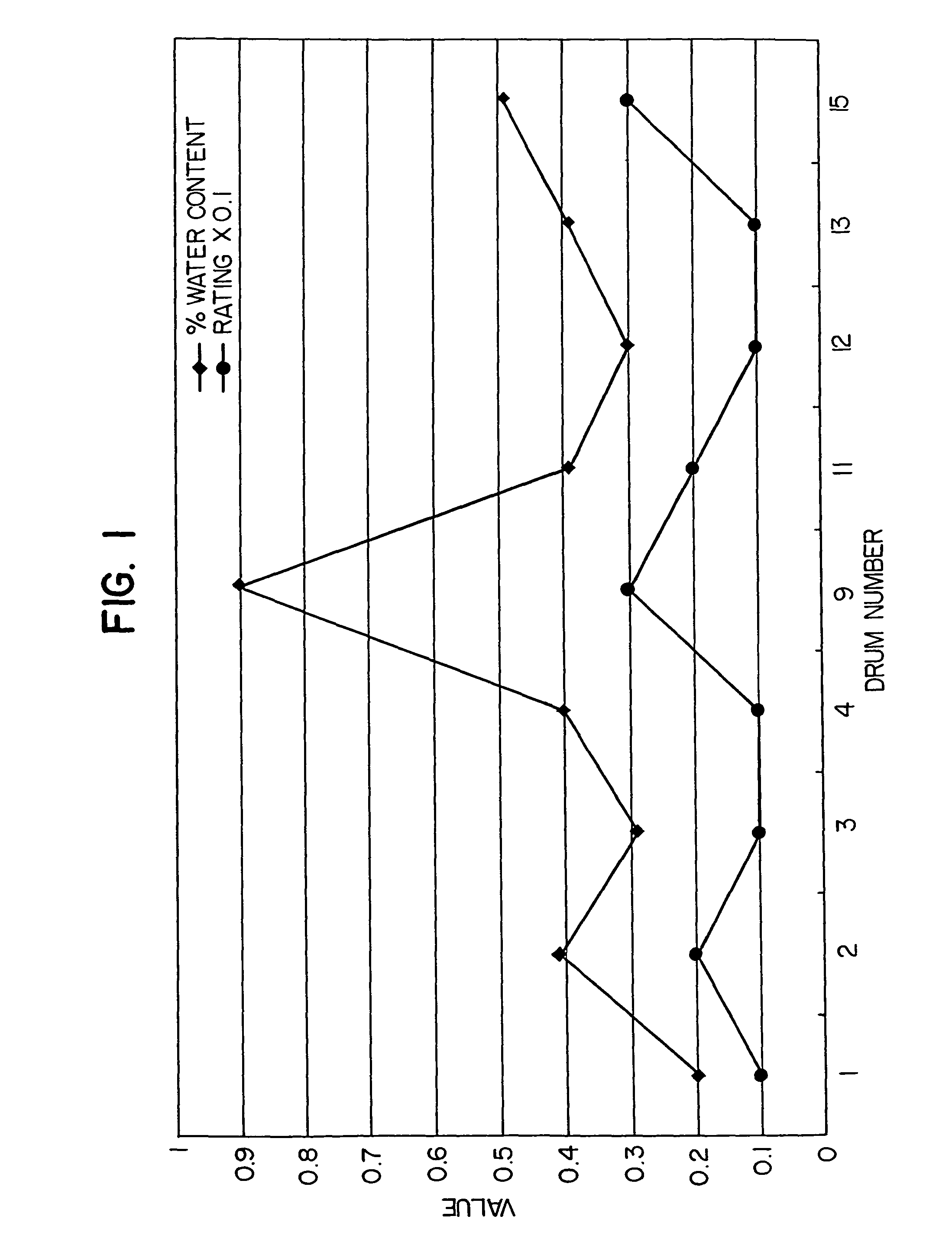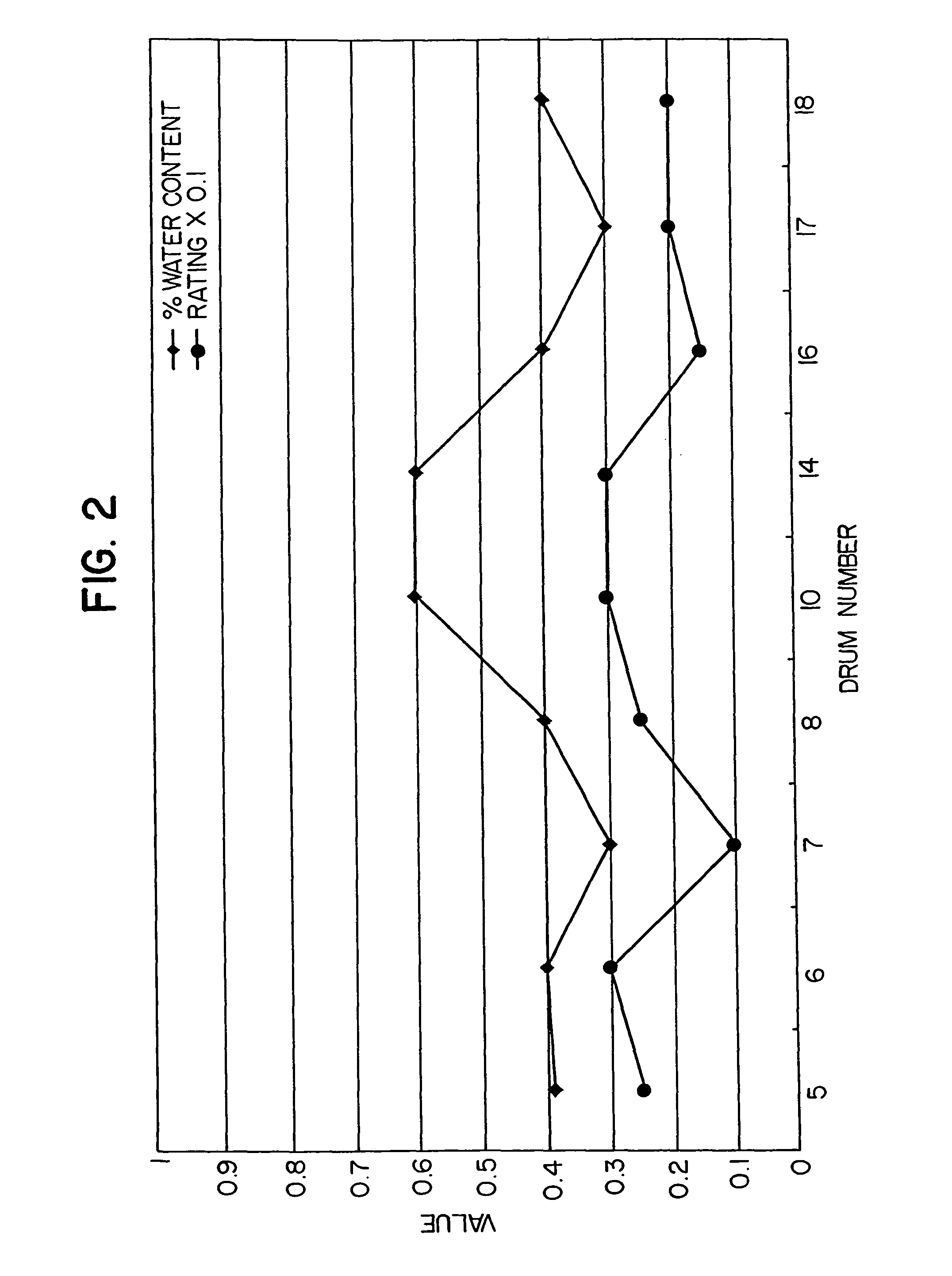Chemically stable, insecticidally active phosphoroamidothioate pellet compositions and methods for their manufacture
a technology of phosphoroamidothioate and composition, which is applied in the direction of phosphorous compound active ingredients, biocide, other domestic articles, etc., can solve the problems of uncommercialized high-strength acephate pellets, large improvement space, undesirable dust, etc., and achieve high strength
- Summary
- Abstract
- Description
- Claims
- Application Information
AI Technical Summary
Benefits of technology
Problems solved by technology
Method used
Image
Examples
example 1
Run 9623201
[0057]Powder feed was started before the water at a rate of 90 lb / hr. The powder was a 98.5% / 1.5% mixture of acephate technical and Agrimer VA-6, as described above. In the past it has proven best to begin extrusion a little on the wet side and slowly decrease the water to the desired rate. The desired rate (1.5%) for the 90 lb / hr of powder was 10 cc / m, or 1.3 lb / hr. The rate used at start-up was between 20 and 30 cc / m (2.6-4.0 lb / hr or 2.8%-4.3%) until noodles were formed. As soon as it was determined the extrusion process (forming noodles) was stable, the water was slowly cut back to between 4 and 10 cc / m. The extrusion process ran steady for over one hour. The material may have been too wet at the start. The initial noodles had a very wet look and had the tendency to stick together. The temperature of the extruder barrel increased considerably as the rate of water was decreased. The extrusion process was running stable.
Run 9623302
[0058]The purpose of this trial was to ...
example 2
[0104]Specific batches of pellets were prepared using the low pressure basket extrusion, as follows:[0105]5 kg of premix (prepared as in Example 1) was weighed into a KDHJ-20 Batch Kneader. The specified amount of water was poured into the kneader, and the mixture was kneaded (mixed) for 4 minutes.[0106]The kneaded mixture was placed into the feed hopper of a BR-200 Granulator and extruded. The screens had 1 mm diameter holes.[0107]The wet, extruded noodles were-swept into a pail for transfer to the dryer.[0108]The extruded noodles were placed into a MDB-400 Fluid Bed Dryer (bed area 0.4306 sq ft).[0109]The drying temperatures were in the range of about 130-140° F. range, and the residence times varied based on moisture content. For the repeat batches (10-25), an 18 min drying time was used.
[0110]The raw data from twenty-three batches thus prepared is set forth below:
[0111]
Batch1234IngredientsOrthene (g)5000500050004000Water (g)250250150280Moisture Level (%)4.84.82.96.5KneaderKDHJ-2...
example 3
[0114]Continuous processing using the low pressure basket extrusion process can be carried out as follows. The same premix technique to prepare a delumped powder as described above in Example 1 was employed. A typical batch size was about 2030 lbs. The continuous process is summarized below:[0115]Drums of premix are discharged into an elevator, and premix is transferred into a blender.[0116]Premix is lifted to another blender. This blender feeds an Acrison powder meter / feeder (140-P).[0117]Premix is fed through the Acrison (140-P) into a kneader (LCI 5BM-57). Water (about 3.5-5%) is monitored onto the powder bed in the kneader. The damp feed falls from the kneader into the extruder (LCI BR-200 Granulator).[0118]A pump and flow meter are used to control the water addition to the premix. The water and powder flow rates are controlled independently by the operators. Samples of the kneaded mixtures are assayed for water content on a ¼ or ½ hour schedule. Water contents were varied (3-5....
PUM
| Property | Measurement | Unit |
|---|---|---|
| density | aaaaa | aaaaa |
| density | aaaaa | aaaaa |
| humidity | aaaaa | aaaaa |
Abstract
Description
Claims
Application Information
 Login to View More
Login to View More - R&D
- Intellectual Property
- Life Sciences
- Materials
- Tech Scout
- Unparalleled Data Quality
- Higher Quality Content
- 60% Fewer Hallucinations
Browse by: Latest US Patents, China's latest patents, Technical Efficacy Thesaurus, Application Domain, Technology Topic, Popular Technical Reports.
© 2025 PatSnap. All rights reserved.Legal|Privacy policy|Modern Slavery Act Transparency Statement|Sitemap|About US| Contact US: help@patsnap.com



